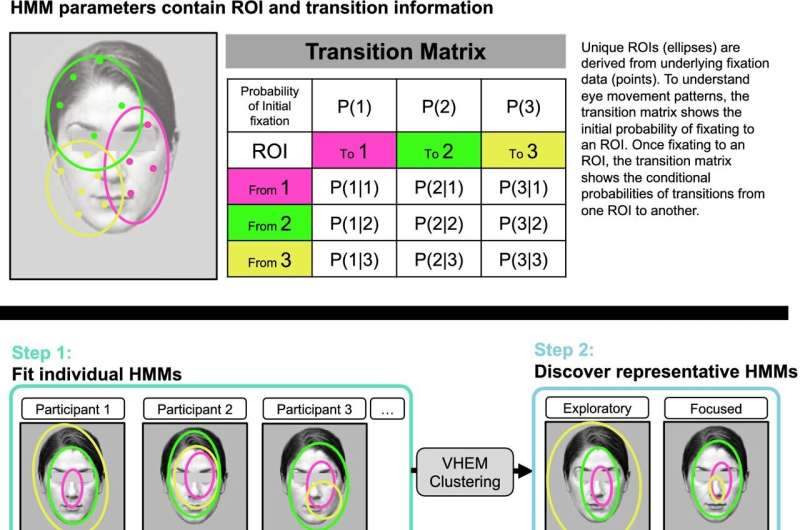This article has been reviewed according to Science X's editorial process and policies. Editors have highlighted the following attributes while ensuring the content's credibility:
fact-checked
peer-reviewed publication
trusted source
proofread
Is eye movement in autism tied to facial recognition?

Some teenagers with autism use a different set of eye-movement patterns from their non-autistic counterparts while recognizing faces, according to James McPartland, Ph.D., Harris Professor in the Yale Child Study Center (YCSC) and a director of the Center for Brain and Mind Health at Yale School of Medicine; and Jason Griffin, Ph.D., the Hilibrand Postdoctoral Fellow at YCSC. Eye movements are part of the process of telling people apart and could provide information to clinicians about how people with autism process social information differently from non-autistic persons.
Autism is a complex neurodevelopmental condition that tends to present itself very differently across the spectrum that defines it. Characteristics of the condition can include differences in language and other aspects of development, as well as heightened sensory sensitivity. But one near-universal autistic trait is a tendency to interact with people in ways that differ from neurotypical people.
One example of this is that people with autism often spend less time making eye contact with others. While not universal, this trait has become the focus of many research studies that seek to explain how the minds of people with autism work.
In a study published in the Journal of Autism and Developmental Disorders, first author Griffin, along with McPartland and colleagues, used a new analysis of existing eye-tracking data from teenagers with autism to see if they could gain new insights into how teens on the spectrum learn and recognize human faces.
The study found that, while teens in the study recalled upright faces as accurately as their non-autistic peers, they took a different approach with their gaze—focusing intently on just one section of the face. The discovery could one day be used by clinicians as a trait to specify potential autistic sub-groups, says McPartland.
The accuracy of the facial recall was actually an uncommon finding. In many previous studies, Griffin notes, young people with autism have shown reduced accuracy in recognizing faces.
How teens with autism memorize a face
Studying and memorizing faces is one of the main ways that people learn to tell people apart. Human brains adapted to register the details of hundreds of faces—a system that helps us distinguish among strangers, friends, and acquaintances,
One of the ways researchers have tried to study this process is through tracking eye movements. However, most of the studies on eye movements in people with autism have tended to focus on analyzing isolated aspects of these data —things like how often or how long someone looks at another person's mouth or eyes.
Hoping to look at the larger pattern of eye movement, Griffin and the research team re-analyzed data collected by McPartland for his doctoral dissertation two decades ago. The original experiment asked 32 teenagers between ages 12 and 17—15 of whom had autism—to memorize the faces of strangers.
The teens were then tested to see if they could distinguish between new faces and ones they'd previously been shown. A camera attached to a baseball cap worn by the participants allowed the researchers to track eye movement during the experiment.
In the new analysis, Griffin tracked which parts of the face the teenagers looked at for 10 seconds at a time. Two patterns emerged: While memorizing faces, teens both with and without autism focused on a small region of the face. But when shown the same face later, neurotypical teens would start with a focused look before darting their eyes to other parts of the face. Teens with autism, on the other hand, stayed focused on just one spot.
Finding biomarkers to identify sub-groups of autism
Exactly what this finding means is still unclear. One possibility is that teenagers with autism use intense focal gazes as a compensatory strategy to ensure they can recall whose face they are looking at. But on the question of why kids with autism operate differently here, "we just know that they do," says McPartland.
However, the findings could be incorporated into part of a larger collection of biomarkers to help identify sub-categories of autism. Autism comes in many forms—and understanding the tendencies of each group could help people prepare for long-term outcomes, such as how much support, if any, they might require.
McPartland and his colleagues are now planning to deploy this same method on a larger dataset with several hundred people with autism to see whether they can categorize eye movement and face recognition in novel ways.
"For a condition that has been studied intensely for a long time, there's surprisingly little we know with certainty," says McPartland. He hopes that studying these types of differences will help clinicians better understand the condition and how to help their patients.
More information: Jason W. Griffin et al, Autistic Individuals Do Not Alter Visual Processing Strategy During Encoding Versus Recognition of Faces: A Hidden Markov Modeling Approach, Journal of Autism and Developmental Disorders (2024). DOI: 10.1007/s10803-024-06259-9





















